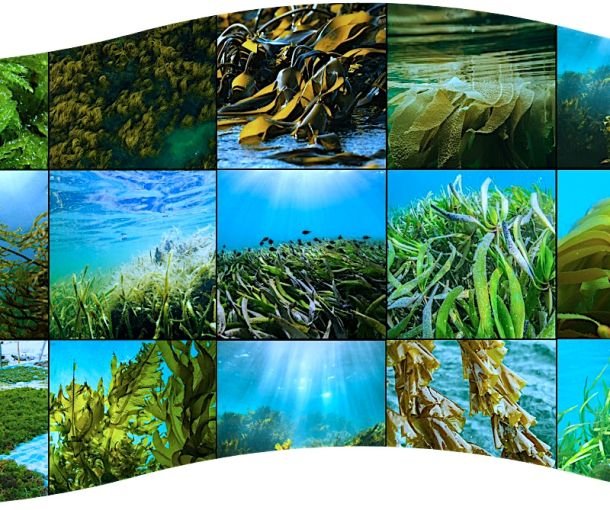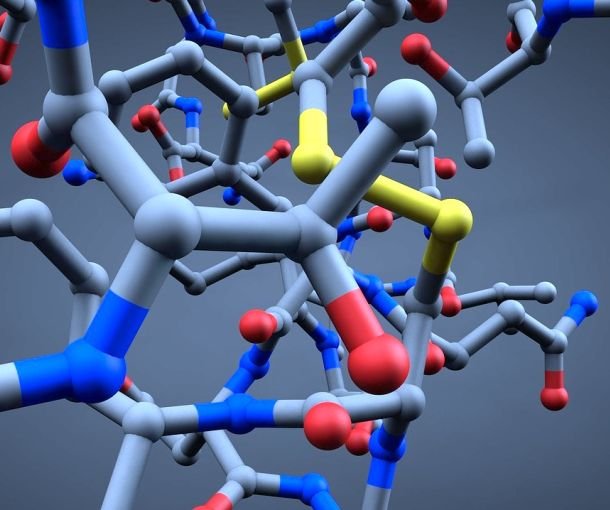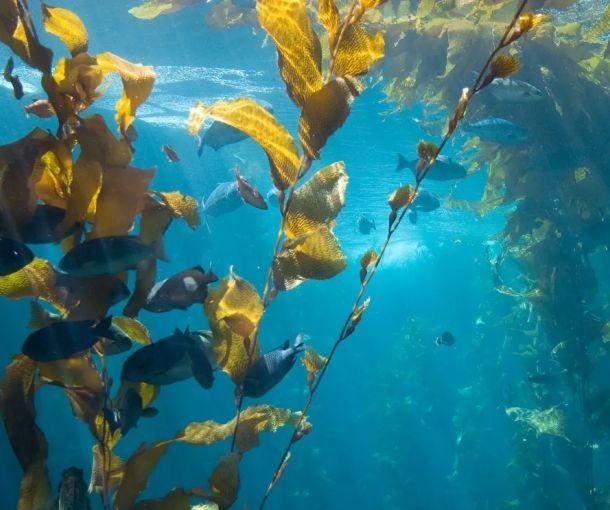Unveiling the Seaweed Renaissance: Crafting Regenerative Macroalgae Biomaterials for Sustainable Wearable Textiles

Introduction
The global textiles industry, a juggernaut in the world economy, has long been a source of both innovation and environmental concern. Its reliance on synthetic materials like polyester, derived from fossil fuels, has raised alarms about sustainability and pollution. As consumers and industries alike seek eco-friendly alternatives, a new player is emerging from the depths of our oceans: macroalgae. These unassuming marine plants, often found swaying gracefully beneath the waves, are poised to disrupt the textile industry with their potential to create sustainable biomaterials.
The current textiles industry, dominated by synthetic fibers, has brought convenience and affordability to the masses. However, it also bears the burden of environmental degradation, from energy-intensive production processes to the accumulation of non-biodegradable waste. As the call for sustainability intensifies, the textile industry stands at a crossroads, poised for a transformation that aligns with the principles of a circular and regenerative economy.
Seaweed, with its unique attributes, holds the promise of leading this transformation. Its abundance, renewability, and diverse chemical and physical properties offer a compelling proposition for the creation of sustainable biomaterials. By harnessing the power of different types of seaweed, from kelp to dulse, we have the potential to create textiles that not only rival the performance of synthetic counterparts but also reduce the environmental footprint of the industry.
In this comprehensive exploration, we will embark on a journey through the burgeoning field of seaweed biomaterials. We will uncover the most likely regenerative biomaterials and biopolymers that can be derived from diverse seaweed species, each with its unique qualities and potential applications. From bioengineered kelp fibers that promise moisture-wicking sportswear to dulse-based natural dyes that bring vibrant colors to sustainable fashion, the world of seaweed textiles is both innovative and sustainable.
As the textiles industry grapples with sustainability challenges, seaweed biomaterials are poised to become a major player in this evolving landscape. They offer the possibility of reducing the industry’s reliance on traditional synthetics, ushering in a new era where fashion and sustainability seamlessly coexist. Join us on this voyage as we delve into the depths of the oceans to uncover the future of wearable textiles, a future where macroalgae-based materials play a pivotal role in shaping a more sustainable and stylish world.
Kelp: The Giant of Sustainability
Kelp, with its towering fronds that sway rhythmically beneath the waves, presents a remarkable opportunity for sustainable textile production. Its composition rich in alginate, a natural biopolymer, offers the potential to create eco-friendly fibers. To bioengineer kelp at scale, researchers are developing innovative extraction methods and processing techniques. Alginate-based fibers are not only biodegradable but also possess moisture-wicking properties, making them ideal for sportswear and activewear.
Dulse: A Colorful Revolution
Dulse, the red seaweed adorning intertidal zones, holds promise in the quest for sustainable dyes in textiles. The vibrant pigments present in dulse can be extracted and applied to fabrics without the need for harsh chemicals. Bioengineered dulse pigments not only reduce the environmental impact of textile dyeing but also provide unique colors and UV-blocking properties for sun-resistant clothing.
Sargassum: From Ocean Drifters to Sustainable Fabrics
Sargassum, often seen drifting in vast mats in the open ocean, is a potential source of biopolymers like cellulose. Researchers are exploring ways to cultivate and bioengineer sargassum-derived cellulose for textile applications. These cellulose fibers, when woven into fabrics, offer breathability and comfort, making them suitable for a range of clothing, from casual wear to undergarments.
Ulva: The Green Promise
Ulva, the bright green seaweed that adorns rocky shores, is rich in proteins and antioxidants. Researchers are working on bioengineering methods to extract and process Ulva proteins into biodegradable fibers with antibacterial properties. These fibers have the potential to create sustainable sportswear and innerwear, reducing the need for synthetic materials with antimicrobial treatments.
Scaling Bioengineering for Seaweed Textiles
he promise of seaweed-derived biomaterials for wearable textiles is tantalizing, but the path to scale up their production is not without its hurdles. Here, we explore the intricate challenges encompassing bioengineering, financial viability, environmental considerations, adoption by the industry, and supply reliability.
Bioengineering Breakthroughs
Bioengineering Challenge: Scaling up the production of seaweed-derived biomaterials necessitates innovation in cultivation methods, extraction processes, and material optimization. Bioengineers are tasked with developing cost-effective and efficient techniques to harness the full potential of seaweed.
Progress: Researchers are exploring advancements in seaweed cultivation, including integrated multi-trophic aquaculture systems that combine seaweed with fish or shellfish farming. Moreover, genetic modification techniques are being explored to enhance seaweed’s growth rate and biopolymer content.
Financial Feasibility
Financial Challenge: Establishing large-scale seaweed cultivation and biomaterial production facilities requires substantial investment. The financial viability of these endeavors, in comparison to conventional textile manufacturing, is a significant concern.
Progress: Government incentives and grants are increasingly supporting sustainable initiatives, making it more financially attractive for businesses to invest in seaweed-based textiles. As economies of scale are achieved, the cost-effectiveness of seaweed biomaterials is expected to improve.
Environmental Impact
Environmental Challenge: While seaweed biomaterials are touted for their sustainability, the environmental impact of large-scale seaweed cultivation and processing must be carefully managed. It is vital to prevent unintended consequences on marine ecosystems and water quality.
Progress: Sustainable seaweed farming practices, such as selective harvesting and minimizing nutrient inputs, are being developed to mitigate environmental impacts. Collaboration between researchers and environmental organizations helps ensure responsible growth.
Industry Adoption
Adoption Challenge: Convincing the textile industry to embrace seaweed-derived biomaterials requires overcoming traditional mindsets and supply chain adaptations. This transition necessitates a shift in industry norms and practices.
Progress: Forward-thinking fashion brands are leading the way by incorporating seaweed textiles into their collections. As consumer demand for sustainable fashion grows, more players in the industry are exploring the adoption of seaweed-based materials.
Supply Reliability
Supply Challenge: Ensuring a consistent and reliable supply of high-quality seaweed biomass is essential for large-scale production. Seasonal variations, weather-dependent growth, and potential competition for seaweed resources pose supply challenges.
Progress: Research into seaweed cultivation techniques that allow for year-round harvest and the establishment of dedicated seaweed farms are steps toward ensuring a reliable supply chain. Collaboration between seaweed farmers and textile manufacturers enhances supply chain stability.
Scaling up the bioengineering of seaweed-derived biomaterials for wearable textiles is indeed a complex endeavor, entailing technological innovation, financial considerations, environmental stewardship, industry-wide adoption, and supply chain reliability. Yet, despite these multifaceted challenges, the momentum in this field is undeniable. Researchers, businesses, and governments worldwide are collaborating to surmount these hurdles and realize the full potential of seaweed biomaterials. As the textile industry continues to evolve toward sustainability, seaweed-based textiles are poised to make a significant impact, offering not just an alternative but a regenerative solution for a more eco-conscious and stylish future.
Recent Developments and Trends in Seaweed/Macroalgae-Based Textiles
Seaweed Fiber Blends
The textile industry is witnessing a burgeoning trend in blending seaweed-derived fibers with other sustainable materials. This strategic fusion aims to harness the strengths of both materials, creating textiles that are not only eco-friendly but also possess enhanced properties. For instance, blending seaweed fibers with organic cotton or bamboo can result in fabrics that combine the natural softness and breathability of these materials with the moisture-wicking and antibacterial qualities of seaweed. Such blends cater to a broader spectrum of consumer preferences, from those seeking utmost comfort to those prioritizing performance wear.
Circular Fashion Initiatives
Circular fashion, which emphasizes reducing waste and promoting sustainable product lifecycles, is gaining significant traction in the industry. Seaweed-based textiles align seamlessly with this ethos. Brands are increasingly investing in recycling and upcycling seaweed textiles to extend their usability and reduce their environmental impact. This circular approach not only minimizes textile waste but also fosters a sense of responsibility and longevity in fashion consumption. It’s a transformative trend that promises to reshape the industry’s relationship with textiles.
Consumer Awareness and Transparency
In an era of heightened environmental consciousness, consumers are demanding transparency from fashion brands. They want to know not only where their garments come from but also how they impact the planet. As a result, brands are increasingly transparent about their sourcing and production methods, showcasing their commitment to sustainability. Seaweed-based textiles, with their regenerative and biodegradable properties, are poised to capture the attention of eco-conscious consumers. This trend not only promotes sustainable fashion choices but also compels brands to innovate and adopt more responsible practices.
Regulatory Frameworks and Certifications
As seaweed-based textiles gain prominence, regulatory bodies and industry organizations are developing standards and certifications to ensure the quality, sustainability, and biodegradability of these materials. These frameworks provide assurance to consumers that seaweed textiles meet rigorous environmental and safety standards. The emergence of recognized certifications fosters trust and confidence in these textiles, encouraging more brands to adopt them. It’s a crucial step toward establishing seaweed-based textiles as a mainstream and reliable choice within the industry.
In the dynamic landscape of sustainable fashion, seaweed-based textiles are not just an alternative; they represent a pioneering force for change. With a focus on blending, circularity, transparency, and certifications, recent developments and trends underscore the industry’s commitment to embracing seaweed biomaterials as a regenerative and eco-friendly solution. As these trends continue to evolve, seaweed textiles are set to become an integral part of a more sustainable and stylish future for fashion.
Seaweed macroalgae, once considered mere oceanic flora, are emerging as champions of sustainability in the wearable textiles industry. Through bioengineering and innovation, these seaweed biomaterials offer regenerative alternatives to traditional synthetics, reducing the industry’s environmental footprint and paving the way for a more sustainable and stylish future.
References:
Wang, L., Wang, A., & Wu, H. (2021). Seaweed-based biomaterials: Extraction, characterization, and applications. Comprehensive Reviews in Food Science and Food Safety, 20(6), 3986-4013.
Li, Z., & Xia, X. (2020). Sustainable textile dyeing with natural dyes from seaweed: A review. Journal of Cleaner Production, 272, 122835.
Zhang, Y., Cui, J., Lyu, Q., Ding, Z., & Wu, H. (2022). Seaweed cellulose fibers: A review on structure, properties, and applications. Carbohydrate Polymers, 280, 119325.
Gubner, R., & Matos, J. (2021). Seaweed-based textiles: A sustainable path for the fashion industry. Journal of Textile Science & Fashion Technology, 7(2), 1-3.


